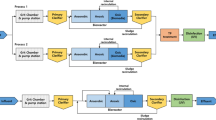Abstract
Transformation of di-n-butyl phthalate (DBP) was investigated in anaerobic/anoxic/oxic (A/A/O) leachate treatment processes. Good removal was achieved under A/A/O conditions. Although the DBP removal was affected by the initial DBP concentration, the overall DBP removal efficiencies for this system were high (> 94%). Only traces of DBP remained in the effluent. The results of mass balance calculations indicated that approximately 33.7–50.7% of the DBP was degraded by the activated sludge, 48.9–64.9% accumulated in the system, and 0.4–1.4% was contained in the final effluent. This confirms that biodegradation and adsorption to activated sludge are both major mechanisms for DBP removal from leachate. The results of correlations between the DBP removal efficiencies and leachate contaminants indicated that the total nitrogen (TN) and total phosphorus (TP) may be key factors influencing the biodegradation of DBP. Half of the DBP in the system adsorbs on the activated sludge. This differs from previous studies in which DBP was mostly biodegraded. DBP is not completely removed when it adsorbs onto sludge. Therefore, methods for decreasing DBP adsorption and increasing the biodegradation efficiencies of the leachate treatment processes should be investigated in future.





Similar content being viewed by others
References
Mo CH, Cai QY, Li YH, Zeng QY (2008) Occurrence of priority organic pollutants in the fertilizers. China J Hazard Mater 152:1208–1213
Sylwia FK, Mattia P, Aneta L (2017) Fate and significance of phthalates and bisphenol A in liquid by-products generated during municipal solid waste mechanical-biological pre-treatment and disposal. Waste Manag 64:28–38
Gao ML, Zhang Y, Gong XL, Song ZG, Guo ZY (2018) Removal mechanism of di-n-butyl phthalate and oxytetracycline from aqueous solutions by nano-manganese dioxide modified biochar. Environ Sci Pollut Res 25:7796–7807
Lottrup G, Andersson AM, Leffers H, Mortensen GK, Toppari J, Skakkebaeek NE, Main KM (2006) Possible impact of phthalates on infant reproductive health. Int J Androl 29:172–180
Liang DW, Zhang T, Fang HH (2008) Phthalates biodegradation in the environment. Appl Microbiol Biotechnol 80:183–198
Wang YY, Miao B, Hou DM, Wu XL, Peng B (2012) Biodegradation of di-n-butyl phthalate and expression of the 3,4-phthalate dioxygenase gene in Arthrobacter sp. ZH2 strain. Process Biochem 47:936–940
Fang CR, Long YY, Shen DS (2015) The influences of different organic fractions in refuse on the sorption and bioavailability of dibutyl phthalate. Chem Ecol 31:539–549
He R, Su Y, Ma RC, Zhuang SL (2018) Characterization of toluene metabolism by methanotroph and its effect on methane oxidation. Environ Sci Pollut Res 25:16816–16824
Liu WJ, Long YY, Fang Y, Ying LY, Shen DS (2018) A novel aerobic sulfate reduction process in landfill mineralized refuse. Sci Total Environ 637–638:174–181
Asakura H, Matsuto T, Tanaka N (2004) Behavior of endocrine-disrupting chemicals in leachate from MSW landfill sites in Japan. Waste Manag 24:613–622
Fang CR, Long YY, Shen DS (2009) Comparison on the removal of phthalic acid diesters in a bioreactor landfill and a conventional landfill. Bioresour Technol 100:5664–5670
Zheng Z, Zhang H, He PJ, Shao LM, Chen Y, Pang L (2009) Co-removal of phthalic acid esters with dissolved organic matter from landfill leachate by coagulation and flocculation process. Chemosphere 75:180–186
Boonnorat J, Chiemchaisri C, Chiemchaisri W, Yamamoto K (2014) Removals of phenolic compounds and phthalic acid esters in landfill leachate by microbial sludge of two-stage membrane bioreactor. J Hazard Mater 277:93–101
Fang CR, Chu YX, Jiang LH, Wang H, Long YY, Shen DS (2018) Removal of phthalic acid diesters through a municipal solid waste landfill leachate treatment process. J Mater Cycles Waste 20:585–591
He PJ, Zheng Z, Zhang H, Shao LM, Tang QY (2009) PAEs and BPA removal in landfill leachate with Fenton process and its relationship with leachate DOM composition. Sci Total Environ 407:4928–4933
Zhang QQ, Tian BH, Zhang X, Ghuman A, Fang CR, He R (2013) Investigation on characteristics of leachate and concentrated leachate in three landfill leachate treatment plants. Waste Manag 33:2277–2286
Adhoum N, Monser L (2004) Removal of phthalate on modified activated carbon application to the treatment of industrial wastewater. Sep Purif Technol 38:233–239
Herbert HP, Zeng FH (2004) Adsorption of phthalates by activated sludge and its biopolymers. Environ Technol 25:757–761
Fang CR, Long YY, Shen DS (2014) Sorption behavior of dibutyl phthalate and dioctyl phthalate by aged refuse. Environ Sci Pollut Res 21:7641–7649
Liu HY, Chu YX, Fang CR (2016) Removal of phthalic acid diesters in the municipal solid waste incineration plant leachate treatment process. Environ Eng Manag J 15:2127–2133
Huang MZ, Ma YW, Wang Y, Wan JQ, Zhang HP (2010) The fate of di-n-butyl phthalate in a laboratory-scale anaerobic/anoxic/oxic wastewater treatment process. Bioresour Technol 101:7767–7772
Lu L, Liu W, Cui F, Xu N, Xu S, Ni JR (2012) Removal of DBP and DEHP in combined landfill leachate treatment process. Chin J Environ Eng 6:2295–2302
Zhou YQ, Liu YX (2013) Occurrence and fate of phthalates in wastewater treatment plants in Beijing, China. Environ Sci 34:1357–1362
Acknowledgements
This work was funded by the National Natural Science Foundation of China (Grant nos. 51678531, 51878617, 51778579, and 21876165). We thank Gabrielle David, Ph.D., from Liwen Bianji, Edanz Group China (www.liwenbianji.cn/ac), for editing the English text of a draft of this manuscript.
Author information
Authors and Affiliations
Corresponding author
Additional information
Publisher's Note
Springer Nature remains neutral with regard to jurisdictional claims in published maps and institutional affiliations.
Rights and permissions
About this article
Cite this article
Fang, C., Mao, H., Jiang, L. et al. Transformation of di-n-butyl phthalate in an anaerobic/anoxic/oxic leachate treatment process. J Mater Cycles Waste Manag 22, 221–227 (2020). https://doi.org/10.1007/s10163-019-00930-5
Received:
Accepted:
Published:
Issue Date:
DOI: https://doi.org/10.1007/s10163-019-00930-5




